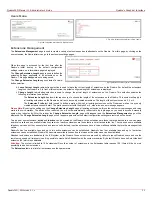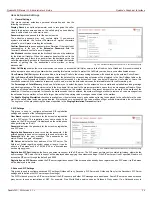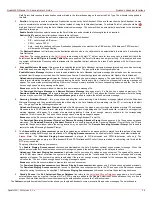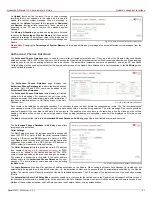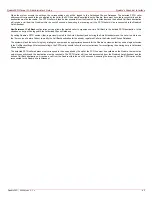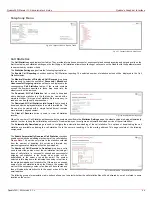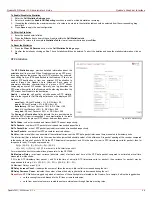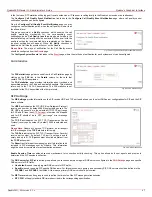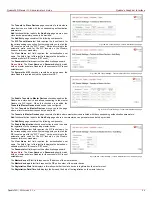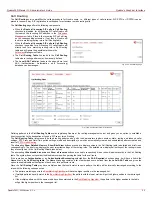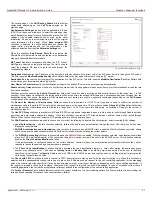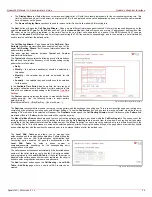
QuadroFXO Manual II: Administrator's Guide
Quadro's Graphical Interface
QuadroFXO; SW Version 5.1.x
46
To Enable/Disable the Statistics
1.
Enter
the
Call Statistics Settings page.
2.
Select or deselect the Enable Call Reporting checkbox to enable or disable statistics recording.
3.
If enabling the statistics, the maximum number of records to be stored in the statistics table should be selected from the corresponding drop
down lists.
4.
Press
Save to apply the new configuration.
To Filter the Statistics
1.
Enter the desired criteria fields.
2.
Press
the
Filter button to search the call reports within the Call Statistics table.
Please Note:
To return to the complete Statistics Table, clear all search criteria and press Filter.
To Reset the Statistics
1.
Press
the
Clear All Records button in the Call Statistics Settings page.
2.
Confirm the deletion by clicking on Yes. The call statistics will then be deleted. To abort the deletion and keep the statistics information, click on
No.
RTP Statistics
The RTP Statistics page provides detailed information about the
established call is provided. When Quadro serves as an RTP proxy,
this page displays two groups (legs) of RTP statistics. For example,
when calling from an IP Phone attached to the Quadro’s IP line to an
external SIP destination or from one external SIP destination to
another through the Quadro’s Auto Attendant. Each group of
parameters describes characteristics of a piece of RTP stream
composing an overall SIP session. Normally, one leg describes the
RTP stream from caller to the Quadro and the other leg describes the
RTP stream from Quadro to the destination.
Quality - estimated call quality, which depends on RTP statistic.
Below is the legend for Call Quality definitions on the displayed RTP
Statistics:
excellent – RX Lost Packets < 1% & RX Jitter < 20
good - RX Lost Packets < 5% & RX Jitter < 80
satisfactory - RX Lost Packets < 10% & RX Jitter < 150
bad - RX Lost Packets < 20% & RX Jitter < 200
very bad - RX Lost Packets > 20% or RX Jitter > 200
The Source and Destination fields indicate the two peers between
which the RTP stream is transmitted. The characteristics in the table
below describes to the piece of RTP stream between these peers.
Fig. II-81: RTP Statistics page
Rx/Tx Codec - codec for received and transmitted RTP stream respectively.
Rx/Tx Packets - number of RTP packets received and transmitted respectively.
Rx/Tx Packet Size - size of RTP packet (payload) received and transmitted respectively.
Rx Lost Packets - number of lost RTP packets for received stream.
Rx Jitter - inter-arrival jitter is an estimate of the statistical variance of the RTP data packet inter-arrival time, measured in timestamp units.
The inter-arrival jitter is defined to be the mean deviation (smoothed absolute value) of the difference D in packet spacing at the receiver compared
to the sender for a pair of packets. If Si is the RTP timestamp from packet i, and Ri is the time of arrival in RTP timestamp units for packet i, then for
two packets i and j, D may be expressed as:
D(i,j) = (Rj - Ri) - (Sj - Si) = (Rj - Sj) - (Ri - Si)
J(i) = J(i-1) + (|D(i-1,i)| - J(i-1))/16, where J(i) is Rx Jitter for packet i.
For more details about Jitter calculations, please refer to the RFC1889.
Rx Maximum Delay - maximum variance (absolute value) of actual arrival time of the RTP data packet compared to estimated arrival time,
measured in milliseconds.
If Si is the RTP timestamp from packet i, and Ri is the time of arrival in RTP timestamp units for packet i, then variance for packet i may be
expressed as following: V(i) = |(Ri - R1) - (Si - S1)| = |(Ri - Si) - (R1 - S1)|
Rx Maximum Delay = max V(i) / 8
RX Delay Increase Count – indicates the number of times the delay in jitter buffer is increased during the call.
RX Delay Decrease Count - indicates the number of times the delay in jitter buffer is decreased during the call.
Please Note:
RTP Statistics is logged only when at least one of the call endpoints is located on the Quadro. For example, it will not be logged when:
•
calls incoming from or addressed to the IP lines or remote extension,
•
calls from an external user are routed to another external user through Quadro’s routing rules.

